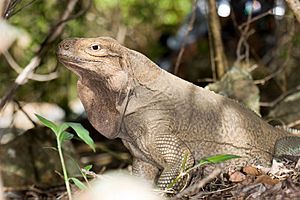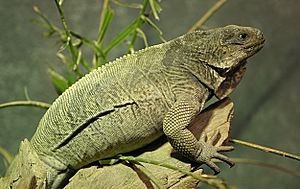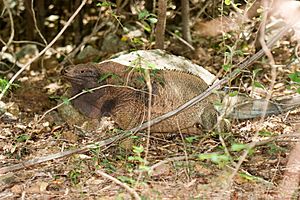Anegada ground iguana facts for kids
Quick facts for kids Anegada ground iguana |
|
|---|---|
 |
|
| In the wild on Anegada | |
| Conservation status | |
| Scientific classification | |
| Genus: |
Cyclura
|
| Species: |
pinguis
|
The Anegada ground iguana (also called the stout iguana) is a large lizard. Its scientific name is Cyclura pinguis. These iguanas are part of a group called rock iguanas. They are found only on the islands of Anegada and Guana today. Long ago, they also lived on Puerto Rico and Saint Thomas. Sadly, their living areas have become much smaller. This iguana is now a critically endangered species. This means it is very close to disappearing forever.
Contents
Anegada Ground Iguana: Natural History
The Anegada ground iguana is special because it is the oldest type of Cyclura iguana. It is also the most different genetically among the rock iguanas of the West Indies. An ancestor of this iguana first traveled to Hispaniola. From there, it moved to islands in the north and west. Over time, this led to the nine different species and many subspecies of Cyclura iguanas we see today.
Naming the Anegada Ground Iguana
An American scientist named Thomas Barbour first described the Anegada ground iguana in 1917. He studied reptiles and amphibians. The scientific name pinguis means "fat" in Latin. This name refers to how stocky or stout the iguana looks. That is why it is also called the "Stout iguana."
What Does the Anegada Ground Iguana Look Like?
The Anegada ground iguana is a big, heavy lizard. It can grow to be about 22 inches (56 cm) long from its nose to the tip of its tail. When they are young, these iguanas have faint or strong patterns. They have wide bands that are gray to moss green. These bands are mixed with wide gray or black V-shapes pointing forward.
As the iguanas get older, these patterns usually fade away. They turn a plain grayish or brownish-black color. They often have some turquoise blue on their back spines, tail base, and legs. Sometimes, this blue color spreads up their sides, especially on males. Female iguanas usually have duller colors. They might have less bright blue, or none at all.
Like other Cyclura iguanas, males and females look different. This is called sexual dimorphism. Males are larger than females. They also have bigger crests on their backs and more noticeable "horns" on their heads. Males have special pores on their thighs called femoral pores. These pores release special scents called pheromones. These scents help them communicate with other iguanas.
What Do Anegada Ground Iguanas Eat?

Most Cyclura iguanas are herbivores. This means they mainly eat plants. They munch on leaves, flowers, and fruits from different plants. However, the Anegada ground iguana faces a challenge. It has to compete for food with farm animals like sheep, goats, burros, and cattle. These animals eat a lot of the plants the iguanas would normally eat.
Because of this, the iguanas are forced to eat plants that these farm animals do not want. This has also made them eat other things. They now sometimes eat centipedes, millipedes, roaches, insects, and other small creatures. This means they are not strict herbivores anymore. They have become opportunistic carnivores, eating what they can find.
Mating and Where They Live
This change in diet has made it harder for the iguanas to have babies. Female iguanas might not get enough food to lay eggs and stay healthy themselves. Many females do not survive after laying their eggs. This has led to a problem where there are two males for every female. Females usually lay one group of about 12 to 16 eggs each year. This happens in late spring or early summer.
Anegada Island is special because it is not a volcanic island. It was formed from coral and limestone. This means it has many natural caves and burrows. These are perfect homes for the iguanas. It was once thought that iguanas would stay with one partner for life. They would live in burrows close to each other. But now, because they have to find more females and compete for food, they move around more. So, this close bonding does not seem to happen as much anymore.
Protecting the Anegada Ground Iguana
Why Are They Endangered?
Scientists believe there are fewer than 300 Anegada ground iguanas left in the world. Their numbers are dropping very quickly. The population has gone down by at least 80% in the last 40 years. This is why they are called "critically endangered."
What Causes Their Decline?
The main reason the Anegada ground iguana's numbers are falling is competition for food. They share their habitat with farm animals like sheep and goats. These animals eat the same plants as the iguanas. Another big problem is that wild dogs and cats hunt and eat the iguanas.
Like other rock iguanas, their homes are also disappearing fast. This is due to new buildings being built and trees being cut down. In the past, some Anegada iguanas were illegally sold to tourists as pets. People wanted them because they were rare. This was against international rules that protect endangered animals.
What Is Being Done to Help?
Many strong efforts are being made to protect this species. In the 1980s, eight iguanas were moved from Anegada to Guana Island. This was done to start a new group of iguanas in an area where they used to live. Guana Island does not have as many natural caves as Anegada. However, the iguanas seem to be doing well there. They are reproducing in areas where there are no wild sheep. The Guana Island Wildlife Sanctuary is working to remove sheep from the island. This will make the habitat better for the iguanas.
The Anegada ground iguana has also been successfully bred at zoos. The San Diego Zoo and the Fort Worth Zoo have helped. They have been working with the British Virgin Islands since 1997. This joint program helps iguanas on Anegada Island. So far, 120 iguanas have been raised at the facility. These young iguanas are then released into the wild. Baby iguanas are fed and protected so they can get a "head start." This helps them grow big enough to avoid being eaten by wild dogs and cats. This program also includes studying iguanas in the wild, protecting their nests, and watching the iguanas that are released.
See also
 In Spanish: Iguana de Puerto Rico para niños
In Spanish: Iguana de Puerto Rico para niños
Images for kids






